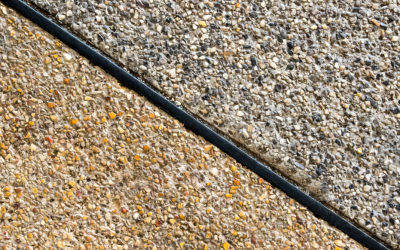Concrete is undeniably durable, which is why it is a commonly used construction material. Its strength and versatility are unmatched, but over time, you may start noticing cracks showing. Cracks can appear in all kinds of concreted areas whether they be shed slabs, patios, or on a concrete driveway. That leaves many homeowners in limbo, wondering if they chose a substandard contractor or if the project was haphazardly done. If you’re wondering what has caused your concrete to crack then continue to read on. Here are some of the most common causes of cracked concrete.
Inadequate drainage, improper soil prep
Proper drainage and well-prepared soil are some of the major keys to ensure cracks do not appear on your concrete slab. If left unnoticed for a long time, excessive pooling water causes damage by seeping into the foundations and the soil beneath the slab, leading to movement and unstable soil, this movement will lead to cracks as well as deteriorating the soil and gravel beneath the slab due to the presence of constant moisture.
In the construction phase, a higher water ratio in the cement mix decreases the strength of your cement. If the preparation of the soil is inadequate, this will also lead to cracks. Excavation is critical to get right, adequate depth will mean that the base layers of soil, sand and gravel will be able to withstand the weight of the concrete without issue.

Trees and plants with deep roots
Plants and trees are a refreshing sight to see, it enhances the aesthetic value of a home. But there are times that when you need to draw a line to protect the integrity of your property.
The proximity of trees and plants with roots that could be invasive to your concrete’s structural integrity. Trees contribute to concrete cracking because they remove water from the soil, directly affecting the soil’s moisture content. This is the start of the movement of the underground soil. This results in shrinkage.
Next thing you know, there is pressure building up underneath, then the cracks start to show up. Roots can grow and spread for a substantial distance from the base of the tree, this means that even if your tree is planted away, consider that the root system could still affect the slab as the roots grow and spread, leading to roots that penetrate the slab leading to cracks and uneven surfaces.
As much as possible, try to put a safe distance when planting ornamental plants or trees. Research which trees are okay to plant near concrete slabs and which are best to be kept well away from concrete.
Thin slab
No matter how strong concrete is, it still has limitations. Seasonal changes in our climate such as drought, floods, and heat also contribute to the movement. The thinner the slab pour is, the easier for cracks to show. Thicker concrete slab foundations offer more weight receiving capacity. Ask your concreter about the right slab specifications that match your property’s daily activities such as foot traffic, weather, and even vehicles that come across your backyard.

Lack of reinforcement bars or wires
Without the help of steel wire mesh or reinforcement bars to help hold the shape of your property’s concrete, the durability and integrity are compromised, and your concrete is vulnerable. Unless your concrete has reinforcements such as rods, or mesh, it might not be able to take a lot of weight without being compromised structurally.
Conclusion: When Cracks Begin To Show…
Some cracks are inevitable, whilst others are completely preventable. Hiring trusted professionals to do the excavation and the concreting job is the best way to ensure a long lasting outcome. Quality doesn’t automatically mean you have to shoulder a hefty price tag for your concreting project either. Simply contact the professional concreters at Concreter Werribee today for a 100% obligation free quote.




